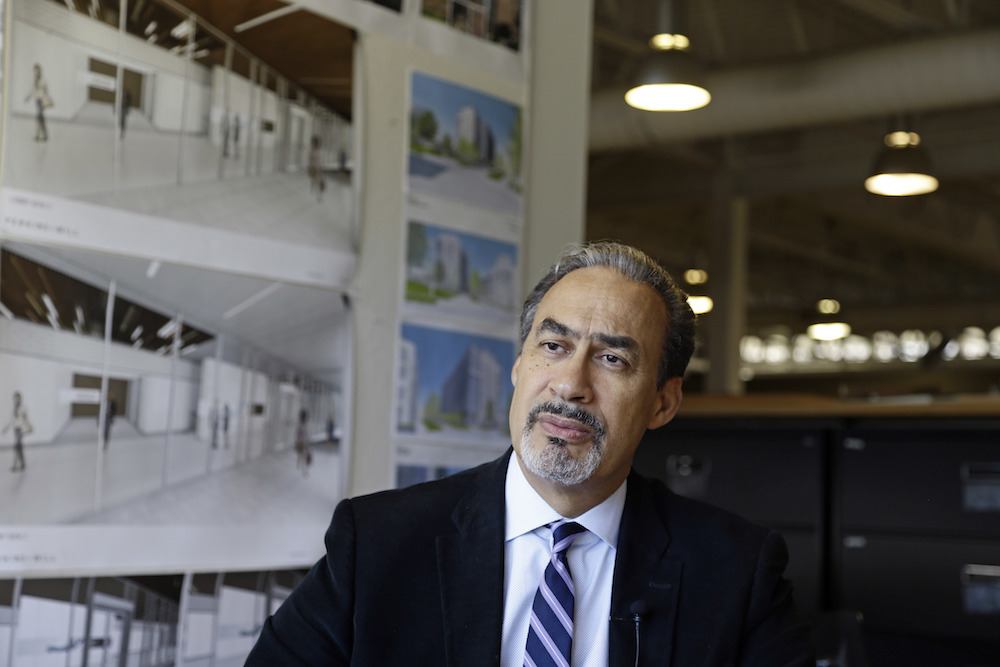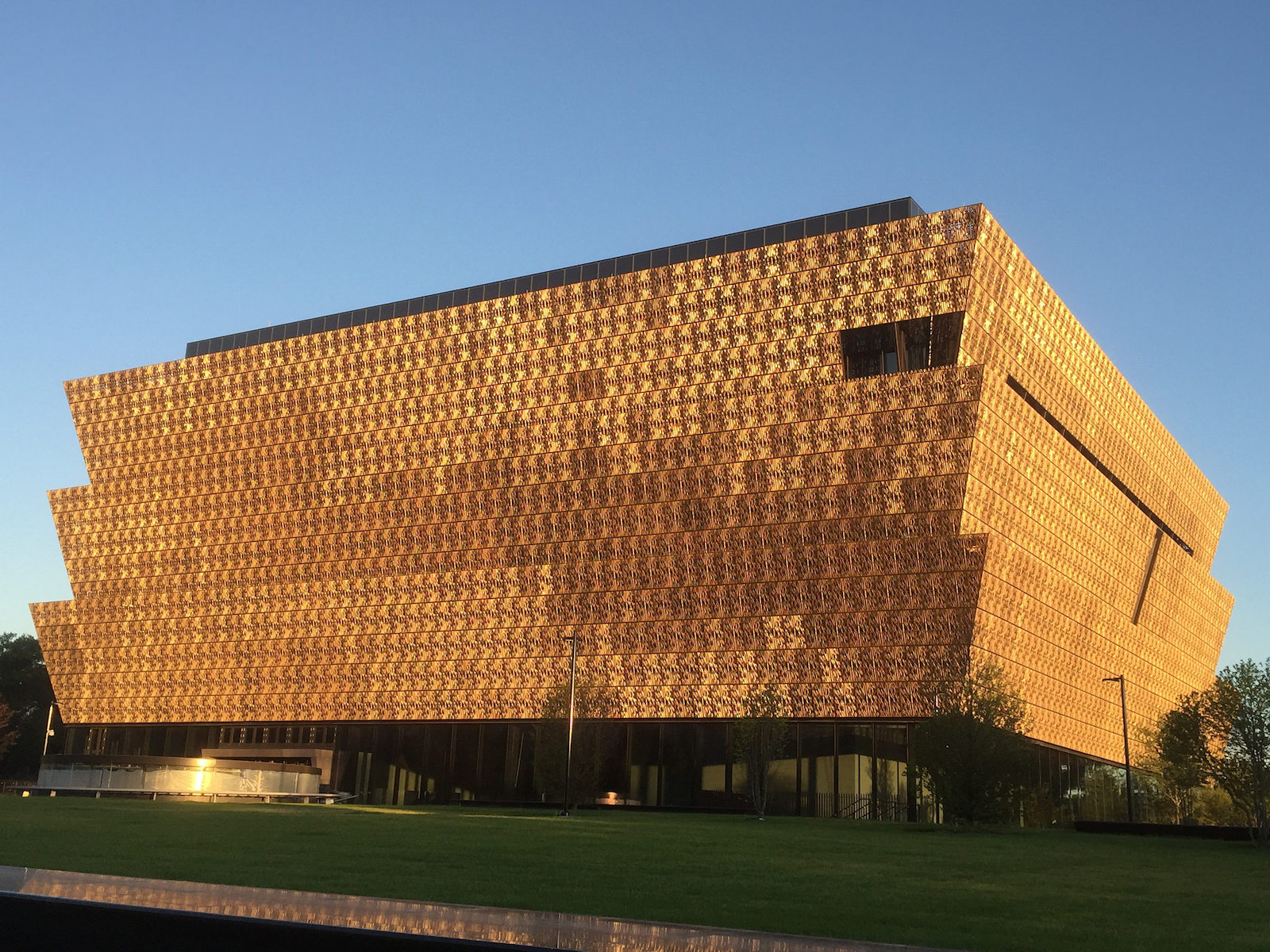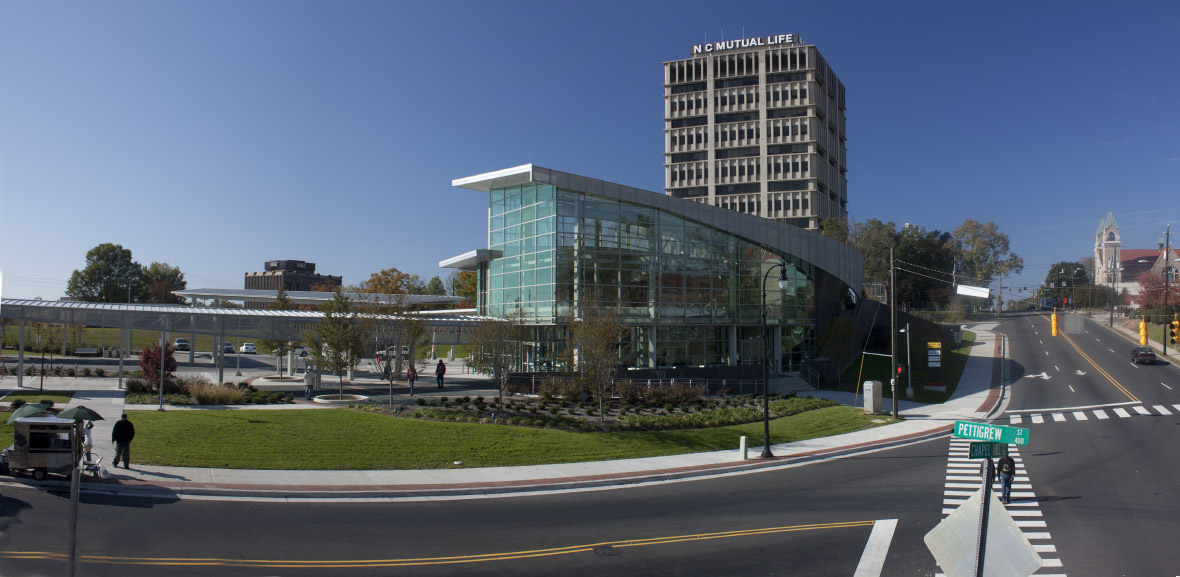In 2017, the Center for the Study of the American South hosted Philip Freelon & Pierce Freelon in conversation for the Charleston Lecture in Southern Affairs. We were grateful to have witnessed Philip Freelon’s generosity and deep humanity as he and his son discussed creativity, community, and the artistry of architecture (among other topics) in front of an audience of friends and admirers.
Renowned architect Philip Freelon, whose work includes the National Museum of African American History and Culture (Smithsonian) and the Sonja Haynes Center for Black Culture and History at UNC, passed away on July 9, 2019. We join the Freelon family and the Durham community in grieving his passing. This conversation, which has been condensed and edited for publication, was moderated by Renée Alexander Craft, writer and Associate Professor of Communication and Curriculum in Global Studies at UNC-Chapel Hill. Pierce Freelon is a musician, entrepreneur, and co-founder of Blackspace, a digital makerspace for Afrofuturists.

Renée Alexander Craft: I am trying to keep myself steady, but inside I’m just kind of dancing all over the place at the opportunity to get to curate this conversation. So I want to start by asking . . . You both have done amazing work creating literal and psychosocial spaces that honor black culture, creativity, and history. What does it mean to spatialize blackness? And if you had to give a set of guiding principles to what constitutes black space, what would it be?
Phil Freelon: For me, as an African American who grew up in the ’50s, ’60s, and ’70s, I feel that my work needs to convey something of our culture. And so early on in my career, I decided to focus my design work on spaces that would inform people, enlighten people, educate folks, bring cultures together. Therefore, museums and libraries and the like—cultural centers and so forth—have been the focus of my practice.
I always had the notion that if the [finished] building is serving the community and is helping to uplift folks, then I feel good about it. And that led me toward these projects, and understandably away from other sort of work, like prisons or casinos—things that I didn’t feel would feed my spirit in that way. So it was quite natural then to infuse some of myself as an artist into these works. And so in that way, I think I can say that making places for people of our culture is part of it, but also spaces that allow people to come together and share different cultures as well.
Pierce Freelon: Yeah, Dad and I come from different mediums. I’m really into theater and music and performance. And when I think about black spaces, I think any space that we occupy as black people—when we kind of resonate and express our cultural vibrations—can be a black space. So when I’m at the house, and my mom [jazz musician Nnenna Freelon] is doing her Ella Fitzgerald scatting thing, or if we’re at a concert, or if I’m at a cypher where there’s a bunch of rappers and MCs and beat-makers together collaborating, I feel like we are summoning our ancestors through that cultural practice. It is very much an extension of our heritage and an expression of our legacy. When we practice this art, we’re essentially welcoming our ancestors into the space, and that, to me, is what transforms the space into a black space. Any space can be a black space.
Renée: How have you all been able to kind of get a seat at the table [and] get yourselves in positions to effect the kind of change that you do? And how have you worked to create . . . intergenerational opportunities for other people to have a seat at the table?
Phil: As an architect, there’s a very prescribed path toward being a professional and a licensed architect. It begins with education, and then you have an internship similar to what doctors and lawyers might do. There’s an examination. And then you work for other people. So I did all those things and kind of learned my craft from observing in the firms where I interned and later worked as a professional. So when I decided to start my own practice, I had a pretty good idea of what I wanted to do, and also what I did not want to do. And I realized that the space in which you’re working is an important part of it. So when I started The Freelon Group, that space became a focus for other people to come and see what architects do. There are very few African American architects in the country. And so my way of addressing that is to try to be more demonstrative about what we do, and invite people in to see it. [S]eeing people of color doing it is really important . . . demonstrating that, “Yes, you can do this, and this is a viable career for young African Americans, and anyone.” You know? The architectural profession is not very diverse, and so we have to work hard at trying to be more inclusive with that.
Renée: Thank you. What about you, Pierce?
Pierce: Yeah, I think about the word Sankofa. You know, there’s a West African symbol. It’s a bird, walking forward, looking backward, kind of has this idea of a cyclical approach to time. And Sankofa, to me, is embodied in my dad’s work in the Smithsonian Museum of African American History and Culture. Walking through that museum, you can see past, present, and future. And I think that, for me, at Blackspace, we call ourselves Afrofuturists. And we root ourselves in the tradition of other Afrofuturists. For me, the quintessential Afrofuturist is Harriet Tubman. And I first heard this articulated by Alexis Pauline Gumbs, who is a Durhamite, radical black feminist intellectual . . .
Renée: Powerhouse.
Pierce: Powerhouse. And I said, “Hmm, Harriet Tubman. Afrofuturist.” She lived in a time and in a place where slavery [was] just the system, the status quo. That is the world that she grew up in. Slavery was this pervasive, powerful mechanism. And she had the audacity to think, “Nah, something else is possible.” Like, “We’re going to figure out some other kind of situation.” [C]rafting the Underground Railroad . . . to me is like Parliament Funkadelic. That’s like the Mothership—”We’re about to get out of here.” They didn’t have the Mothership, so they did the railroad, which was a new technology at the time. And I think about how she used that railroad to get people freedom, manifest the world that was not her present world. And again and again, whether it’s Ella Baker or Ida B. Wells or Billie Holiday, the way that they used their art or their scholarship—whatever tool, whatever gift they had—was being applied to creating a world that we don’t see yet, but we know we need to move towards.
So for me, in the present, I think it’s important for us to create spaces where we envision the future, and we envision the future as it needs to be. How do we do that? I think we do that by rooting ourselves in the past, which is what Sankofa is all about. You can’t understand your future without looking at your past. As Marcus Garvey said, “A people without knowledge of their history is like a tree without roots.” You know? Wind blows a tree without roots—you’re knocked over. You got those roots though, you’re solid. And so I feel like that’s what we need as a people. And what the museum does, for me, that’s a sturdy trunk for our people in this country.
It’s important for us to create spaces where we envision the future, and we envision the future as it needs to be. How do we do that? I think we do that by rooting ourselves in the past, which is what Sankofa is all about.

Renée: It’s so interesting . . . thinking about Sankofa, and thinking about the structure [of the Smithsonian National Museum of African American History and Culture] itself, because it is a structure that has a feel of being both rooted in a past . . . It has a very study look to it. But it also has a kind of spaceship, moving forward, thinking forward, being forward, feel to it.
Phil: If you think about the location in Washington, in the midst of all the other Smithsonian buildings and monuments, many of the buildings are marble or concrete, or these white structures or gray. And so this is a distinctive departure from that intentionally, which is no small feat in D.C. with all the regulations being looked at under a microscope by the regulatory agencies and people, some of whom did not want this to happen. And so the building is simulating a bronze color, a metallic finish that . . . suggests longevity. It suggests quality, permanence. And it can be dark, depending on the light conditions. Or if the sun hits it just right, it can be almost ablaze with reflection of the sunlight. So it’s a dynamic façade that changes in the course of a day and across the seasons. And that, we think, is appropriate because our story isn’t only about victims and perpetrators.
There are dark moments, and we must tell the truth. And that’s important. But it’s also about celebration. It’s about resilience and making a way out of no way. So these things are subtle. The form was derived from a crown-type shape that was part of Yoruban architecture. There’s a form called the caryatid that is a column that has a base, a body, and a capital that has a crown. And the walls are tilted outward in a way that you don’t see in western architecture. And so that distinction, the form, the materiality of it, and the light permeability. Right? There’s light emanating from it at night, and during the day. The pattern that is created by the openings in the corona give a certain feel when you’re inside the building. And even that pattern has a connection back to African American culture. We took those intricate metal designs that you see in places like Charleston and New Orleans, the gilded iron work, and this is a modern interpretation of those patterns.
And all these things are subtle. We want people to scratch their head and think and interpret it in different ways. We’ve had people say, “Okay, it looks like a woman’s hat in church. It looks like . . .” And so there is room for you to bring your own experience and interpret that. It’s not a literal transposition of an idea. But all of our buildings, particularly the ones that have a basis in culture, we want the building to help tell the story, not simply be a beautiful wrapper around content or exhibits. The building itself can help to tell the story and draw people in and be part of a narrative.
Pierce: Don’t y’all love listening to him talk?
Phil: I could talk about this building for a few hours.
Pierce: Yes!

Renée: In other interviews, I’ve heard you say it came along at just the right time . . . that you were prepared at that time. I want to know, what aspects of other projects helped you prepare for some of the things you tried out?
Phil: Well, this building [the Sonja Haynes Stone Center for Black Culture and History] is one of them. This auditorium is the shape that is because it simulates a drum. Again, it’s not literal. You can’t see the skins dressed across the roof or whatever, for example. But, you know, the iconography is there. The columns out front are tapered. That’s another form you don’t see in Western architecture, and that comes from an African tradition. Anyone in the arts would tell you that your personal experiences along the way feed into the next project. You bring something of yourself and your interactions with other people, places you’ve visited, your education, your family is a huge part of this. I happen to consider architecture an art, the original art. It’s art with utility. You get to use it. It has a purpose. And in most cases, you don’t have to pay to go and see it in a museum. People walk through it.
The bus station in Durham—I’m as proud of that building. It’s a beautiful building that everyday people get to see and enjoy architecture at the highest level. And it’s just a bus station. And in most cities, that is not a place you’d want to go or think about as an architectural opportunity.
Renée: What does art have to do with liberation? What does art have to do with helping us move forward in our current civil rights struggle?
There’s an artist inside of all of us. Now, how is it expressed?
Phil: There’s an artist inside of all of us. Now, how is it expressed? You may be a writer, and you may be a chef. You could be an educator. It’s up to each of us to find that thing that feeds our spirit, and how do we help other people through our art? And so we talk to the children about that. I wanted them to understand that these buildings . . . We brought models [into schools] so they could see [them]. And that’s sort of the last few steps of the process. But it’s all about an idea, and how can you get that idea out of your mind, and on paper, or singing, or dancing. Somehow express that thought so that other people can latch onto it, and you can build it together into something that can be shared. And so I wanted to get them to connect with the notion that thoughts can really be powerful things. And when you share a powerful thought and it has momentum then you can really pick up steam with it.

